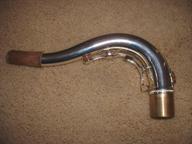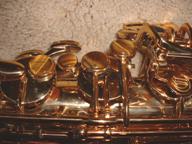

|
SaxophoneMan.com |

|
All Things Saxophone |
|
Cannonball Big Bell Stone Series Tenor Sax |
|
Last modified 09/12/08
|
|
Questions or comments? Send us an email |


|
Cannonball began manufacturing their instruments in 1996. Based in Salt Lake City, they are truly preserving a classic approach to making saxophones. One thing I can say for these horns is they are truly works of art. They are tops in the industry today for making horns with aesthetic appeal. Each saxophone is available in a variety of finishes. See them all at
· Construction, look & feel Because of the great finishes available this horn looks as good as they come, and it can look exactly how YOU want it to. Just like its sister sax the Cannonball Stone Series Alto, this saxophone is ornately engraved and inlaid with semi precious stone on the keys. The one I tried has Tiger Eye (see picture below left). The horn came with two necks — one “Fat Neck” with under slung octave key (pictured below left) and one standard neck. |

|
The necks fit well with the body of the horn and there is a good metal plug for the neck joint on the body of the sax to keep the joint “true”. Pads are good construction with nickel resonators throughout. The horn has good action but I was disappointed with the layout of the spatula keys for low C#, B, & B flat (just like its sister horn the Cannonball Alto). The mechanism is similar to the best construction today but it doesn’t feel as good as the Wellington or the Buffet 400. The transitions between the spatula notes are klunkier than I would expect for a premium horn like this. · Sound The standard neck produces a sound that is somewhat restricted, but the fat neck produces a bigger sound, just not as big as my classic King Super 20. I played this horn and all of the neck combinations with my standard setup (Runyon 7, Zonda 3.5 reed). Here’s a sample of my sound with the Fat Neck doing major arpeggios ascending in a whole tone pattern:
Listen to the Cannonball Stone Series with “Fat Neck”
Now listen to the same motif played on my classic King Super 20 (same mouthpiece and reed setup)
Listen to the King Super 20 Tenor
The King Super 20’s sound is fatter, and being a sound guy that makes the difference for me. · Intonation The horn has some sharp & flat issues in the altissimo — nothing real serious and about equivalent to my King Super 20. The scale is very solid in the standard range of the horn. · Price Cannonball engraves their saxophones with “Designed in USA”. This comes across as a clever marketing maneuver to make the buyer think they are made domestically. The horn is priced higher (about $2700) than the other good horns made overseas in China & Taiwan (like the Wellington Tenor sax) but is definitely less than a Yamaha Custom or the incredibly overpriced Selmer Reference. Well priced, but still not quite the best buy in a saxophone. Also, it’s not available through the Internet — Cannonball has a noble objective for not allowing Internet sales (to support the local music stores and the service they provide to students), but I don’t know if that philosophy will survive in today’s e-commerce environment.
This is a good saxophone — better than the Wellington Tenor sax (although it costs considerably more) but not quite as good as the classic King Super 20. It is however the best looking, most ornate saxophone on the market today. If price is not an issue then this saxophone is a good choice for the aspiring player. |
|
The Cannonball Fat Neck with under slung octave key |

|
Keys on the Cannonball stone series are inlaid with semi-precious stone. This photo is “Tiger Eye”.
|



|
Cannonball Stone Series Tenor Sax with Gold Lacquer “L” finish and fat neck |

|
Cannonball’s signature stone inlay in the neck — this picture is also “Tiger Eye” |